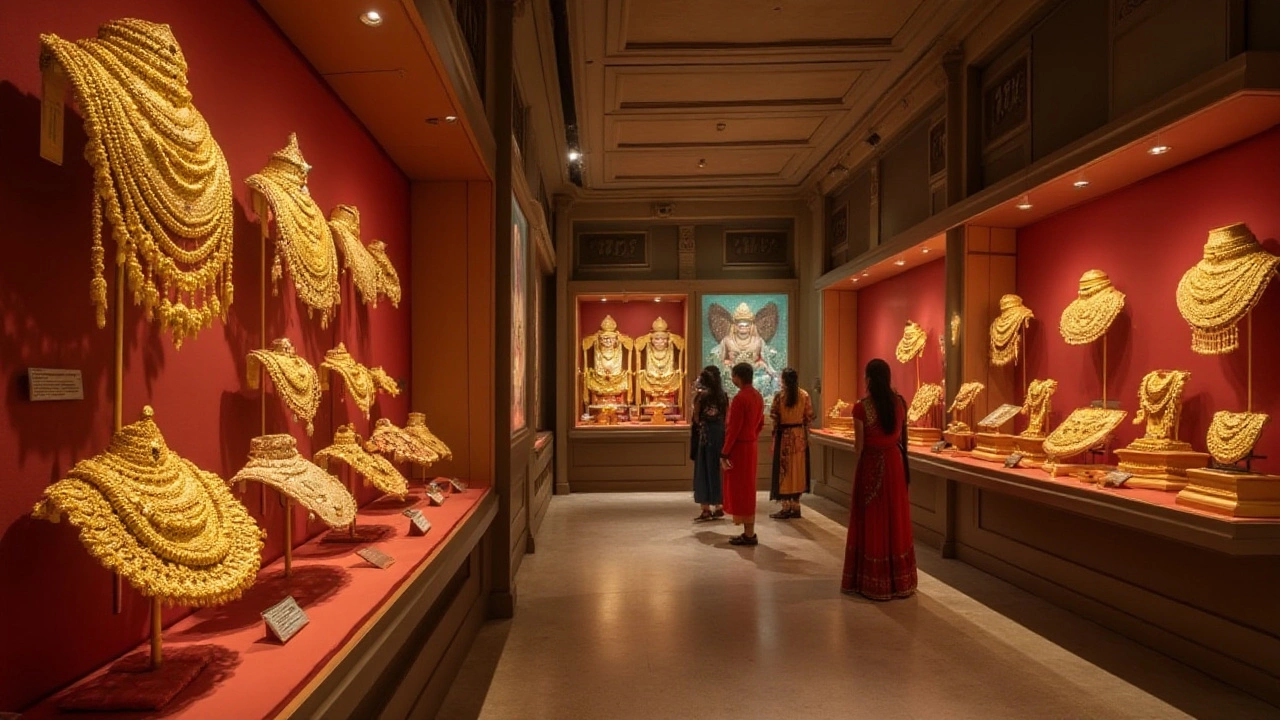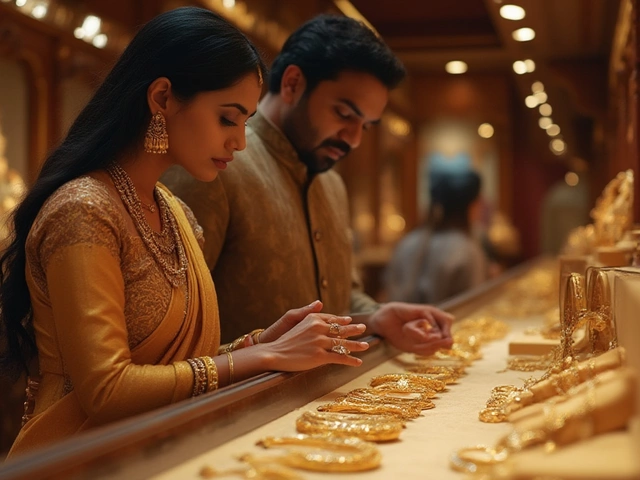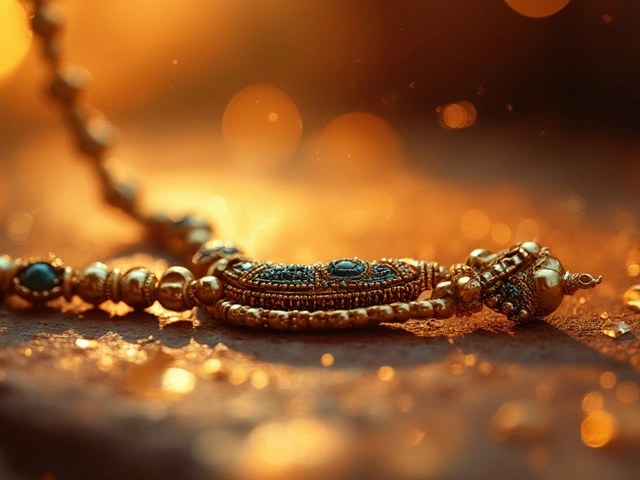Indian temple jewellery is renowned not just for its intricate designs but also for its strikingly rich yellow hue. This shimmering tint has captivated the eyes and hearts of gemstone lovers and historians worldwide, prompting an exploration into its roots and reasons.
The vibrant yellow color observed in Indian gold is more than just a mere aesthetic choice; it is steeped in history, cultural significance, and craftsmanship tradition. From ancient times, gold has been regarded as a symbol of purity and prosperity, with its unique color enhancing these attributes.
When delving into the essence of the golden hue, one begins to appreciate the careful selection of alloys and the exceptional purity levels that craftsmen maintain. These elements come together to impart the gold with its signature luminescent quality. Additionally, the traditional crafting techniques passed down through generations play a crucial role in maintaining this iconic color.
This article will unearth the layers that contribute to the radiant yellow shade of Indian temple jewellery, shedding light on both the scientific and cultural perspectives that make this gold so exceptional. Let's embark on this golden journey.
- The Historical Appeal of Indian Gold
- Cultural Significance of the Golden Hue
- The Role of Alloys and Purity
- Traditional Craftsmanship Techniques
- The Influence of Indian Temple Jewellery
The Historical Appeal of Indian Gold
Delving into the history of Indian gold, especially with its enticing yellow hue, is akin to walking through a richly adorned tapestry of human civilization itself. From as early as the Harappan civilization, gold featured prominently in various artifacts, signifying its importance to the social fabric. It wasn't merely a show of wealth but a representation of divine connection. The sacred texts, such as the Vedas, describe gold as 'the flesh of gods', a material so pure and divine that it forms a natural bridge between the earthly realm and the heavens.
Throughout the centuries, gold has maintained its privileged status. During the Gupta period, often regarded as the golden age of India, gold coins became commonplace. This era saw the proliferation of temple jewellery, which was not only designed to adorn deities but also symbolize prosperity and spiritual wealth. The unique yellow hue of Indian gold was particularly valued, symbolizing the sun's radiance and playing a key role in religious ceremonies, weddings, and rites of passage. As scholar John Smith once observed in his renowned study on ancient Indian metallurgy, "The golden glow of Indian artifacts was not merely an aesthetic choice but a deliberate quest for purity and divine embodiment."
The trade routes of ancient India extended its gold influence far and wide—traders from far-reaching lands like the Roman Empire came to India not just for spices and textiles but also to procure its illustriously yellow gold. These exchanges weren't solely about economics; they were interwoven with cultural exchanges that enriched the social and spiritual life of the time. Gold, with its rich yellow shade, was often used to craft intricate temple jewellery pieces, steeped in symbolism and crafted with remarkable precision.
During the reign of empires like the Cholas and the Marathas, temple jewellery saw its designs become even more elaborate, often incorporating motifs that celebrated cosmic themes. These handcrafted pieces were known for the exquisite manner in which they showcased the full brilliance of Indian gold.
Pilgrims and devotees from various parts of the country would offer gold ornaments to their deities, seeking blessings of prosperity and fortune. This practice is still alive today, with numerous temples across India receiving substantial annual offerings of gold. The persistence of this tradition underscores the continued reverence for gold's mystical allure, deeply rooted in India's cultural psyche.
As history unfolded, the appeal of Indian gold and its vibrant yellow hue only grew stronger. From ancient scriptures to modern-day celebrations, it remains a timeless symbol of wealth, power, and divinity, cementing its legacy as an integral part of Indian heritage. Its golden history is not just about the past; it's a narration that continues to unfold, shaping lives and legacies alike.
Cultural Significance of the Golden Hue
Bright, resplendent, and alluring, the golden hue of Indian gold is profoundly woven into the cultural backdrop of the country. Gold in India transcends mere economics and wealth, branching into spiritual and symbolic realms that have been nurtured over millennia. The vibrancy of this metal, especially in the form of temple jewellery, stands as a testament to a rich history where opulence meets divine reverence. For many Indians, gold represents an eternal connection to their gods and goddesses, celebrated and revered through both religion and tradition.
The lustrous yellow shade is not just a product of metallurgy but also aligns with the symbolism of light, knowledge, and immortality. In Hindu culture, gold is associated with the sun, which is considered the source of all life and the provider of boundless energy. It brings warmth and positivity, aligning perfectly with the cherished characteristics Indians associate with prosperity and happiness. Rural and urban households alike covet gold not just for personal adornment but as sacred possessions with deep cultural meanings. A traditional Indian wedding, for instance, is adorned with gold, signifying purity and financial stability, laying the foundation for a new life marked by prosperity.
The golden hue's symbolic nature extends into auspicious occasions. Festivals like Diwali, Akshaya Tritiya, and Dussehra see families assembling around beautifully crafted gold pieces, believing them to attract good fortune. Indian mythology is rife with references to gold as a vehicle for virtue and status, often depicted in stories entailing gods and celestial beings adorned with gleaming gold jewels. The intrinsic value ascribed to these luminous gold pieces means they are often passed down through generations, intertwining family lineage with deeper cultural heritage. As a result, the Indian household's very foundation seems gilded with the promise of universal abundance and grace.
An interesting aspect of Indian gold's yellow hue lies in its ability to adapt to various regional identities while maintaining consistent cultural significance. In South India, the bold golden hue of temple jewellery often features depictions of deities like Lakshmi and Vishnu, integrating religious artistry into personal adornment. Northern India's ornate Mughal-inspired designs highlight intricate craftsmanship, balancing sleek patterns with gold's natural radiance. Despite these variations, each design emphasizes a commitment to durability, artistry, and spiritual significance, effectively personifying the gold's value beyond monetary worth.
"Gold is the material that the world has chosen for its great value, both spiritually and materially," stated the historian William Dalrymple, underlining the indispensable role gold plays in India's cultural tapestry.

The Role of Alloys and Purity
The distinctive and captivating yellow hue found in Indian gold is not the result of a single factor but rather an intricate dance between the purity of gold and the specific alloys used. In its purest form, gold is extremely soft, making it unsuitable for jewellery, which requires a degree of hardness for longevity. To achieve the desired rigidity, jewellers historically introduced alloys while maintaining a delicate balance to preserve gold's vibrant color. Silver and copper are the primary alloys traditionally blended to create this unique shade of gold. Silver tends to give gold a whitish tone, while copper imparts a reddish hue; the right proportion of these elements enhances the natural brightness that is so distinct in Indian jewellery.
In Indian culture, gold purity is of paramount importance, frequently expressed in karats. The higher the karat number, the higher the purity. For example, 24-karat gold is considered pure gold but is rarely used in jewellery because of its malleability. In contrast, 22-karat gold, containing about 91.67% gold, strikes a balance between durability and appearance, helping to maintain that rich yellow shade. The selection of specific alloys also influences the hue. While the addition of nickel can lead to a paler appearance, the careful crafting process ensures that temple jewellery retains warmth and luminosity.
"The alluring yellow tint of Indian gold is a testament to the country's rich artisanal heritage and a celebration of precision in metallurgy," noted a renowned jeweller in an interview with a prestigious jewellery magazine.
For centuries, Indian artisans have honed their techniques, allowing them to yield gold that exudes both strength and color vibrancy. The process is elaborate and requires skill, often passed down through generations of craftsmen who closely guard their methods. This dedication and expertise enable them to fabricate items that meet the high expectations for both aesthetic appeal and practicality. To comprehend how alloys contribute to making Indian gold so splendidly yellow is to appreciate the meticulous effort that culminates in true artistry.
Interestingly, temple jewellery not only holds value for its color and craftsmanship but is also seen as an embodiment of spiritual purity and divine blessings. Such sentiments have kept rigorous standards at the heart of jewellery creation across the country for countless years. While techniques and technologies have evolved over time, the unyielding pursuit of achieving the ideal hue remains steadfast, a nod to the gold's esteemed status in culture. As we explore the complex relationships between purity, alloys, and color, one begins to see the synergy that gives Indian gold its iconic character, revered and cherished by all who lay eyes upon it.
Traditional Craftsmanship Techniques
When delving into the creation of Indian temple jewellery, one cannot overlook the remarkable traditional craftsmanship techniques that are integral to its allure. These methods have their roots dating back centuries and have been meticulously passed down through generations of craftsmen. The process is both highly skilled and intricate, ensuring that each piece not only holds aesthetic beauty but also cultural significance. Craftsmen often start with selecting the purest form of gold, understanding that the metal's inherent purity plays a vital role in achieving that iconic yellow hue. This selection is guided by age-old beliefs and practices, ensuring a commitment to quality that mere modern machinery struggles to replicate.
One of the hallmark techniques employed in the creation of temple jewellery is the 'lost wax casting' method, also known as 'cire perdue'. This technique involves creating a detailed wax model of the desired piece, which is then encased in clay to form a mold. When the mold is heated, the wax melts and exits, leaving behind a cavity that is then filled with molten gold. The result is a stunningly detailed piece that captures the precision and artistic flair of these master craftsmen, allowing the Indian gold to take center stage with its vibrant color. Interestingly, the secret behind the rich hue also lies in the unique blend of metals that are mixed with gold during the crafting process, such as copper and silver, which enhance the malleability and coloration of the final product.
Perhaps what truly sets Indian temple jewellery apart is the dedication and precision employed in every step of the creation process. Craftsmen use tools that have barely changed over hundreds of years, a testament to the timeless nature of their artistry. They've honed their skills through countless hours of practice, ensuring that even the smallest details are exquisitely executed. The devotion to maintaining such high standards of craftsmanship speaks volumes about the cultural importance of these pieces. As one revered artisan once said,
"In every piece of temple jewellery, there is a story of our ancestors, a reflection of our heritage, and the soul of gold brought to life by skilled hands."
For those interested in the artistry and dedication required to produce Indian temple jewellery, it is essential to appreciate that each piece is truly a labor of love. The artisans begin by shaping gold into thin sheets, which are then meticulously molded into intricate designs by hand. This method not only preserves the natural luster of the gold but also enhances its exceptional durability. It's this hands-on approach that ensures each jewellery piece remains unique, resistant to the uniformity often found in modern jewellery manufacturing. An element of surprise in some pieces can even see the use of enameling, adding splashes of vibrant color that complement the underlying warmth of gold.
The import of these traditional techniques has not waned in any sense over the years. On the contrary, they continue to garner global admiration and inspire new generations of designers. Despite technological advancements in jewellery manufacturing, these age-old practices remind us that true artistry requires patience, passion, and an unwavering respect for tradition. Aspiring artisans continue to travel to villages throughout India, particularly in the southern region, to apprentice under master craftsmen, eager to learn the stories and secrets woven into every swoop and curve. This enduring dedication ensures that the radiant legacy of Indian gold continues to shine brightly, much like the sunlit temples it once adorned.

The Influence of Indian Temple Jewellery
Indian temple jewellery is more than just a beautiful adornment worn during religious ceremonies; it is a symbol rich in cultural significance and historical depth. Historically, this type of jewellery was used to adorn deities in temples across southern India, which is how it got its name. It wasn't just about aesthetic appeal; each piece was believed to hold spiritual power, enhancing the sanctity of the religious idols it adorned. Crafted in gold and often encrusted with precious stones, these elaborate designs have held an enduring appeal through centuries. The unique yellow hue of Indian gold used in temple jewellery stems from the combination of high-purity gold and traditional alloying practices, which reinforce its distinct identity.
The artisans crafting this Indian gold jewellery were considered nothing less than artists. Their role was not merely to manufacture accessories but to create divine elements capable of inviting blessings and prosperity. This intricate art form was passed down through generations, each family safeguarding their unique techniques and designs. Such was the importance attached to the making of these pieces. Seamlessly blending aesthetics with spirituality and functionality, temple jewellery emphasizes durability alongside its divine looks. The gold used is usually 22 or 24 karats, with minimal alloying to retain its high purity, which contributes to its lustrous yellow hue.
Even today, temple jewellery's influence extends far beyond the religious ceremonies it was originally designed for. It has found a place in modern wardrobes, cherished for its beauty and timeless elegance. The vibrant yellow color, paired with intricate designs featuring gods and goddesses or motifs of nature, adds a regal touch to any outfit. Wedding ceremonies often feature these jewellery pieces as central heirlooms, echoing familial bonds and traditions, connecting generations through their shared heritage. Beyond its physical beauty, the jewellery acts as a bridge to the past, a poignant reminder of India’s intricate cultural mosaic.
"Temple jewellery is a testament to the skilled craftsmanship and rich heritage of India. Every piece tells a story," notes Anantha Krishna, a renowned historian focusing on Indian artefacts.
The distinct color of Indian temple jewellery, its faultless craftsmanship, and the cultural beliefs it embodies culminate in an art form revered not just in India but across the globe. Its influence on India's cultural and social landscapes is undeniable, reaching deep into the heart of Indian traditions and modern fashion alike. Whether it's worn by a bride marrying into a family steeped in tradition, or by a dancer performing Bharatanatyam with grace, temple jewellery continues to shine brightly, a luminous thread woven through the fabric of Indian heritage.



